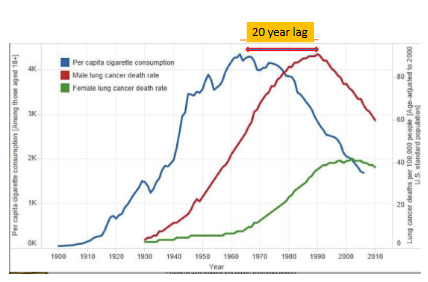Intro to Community Health pt. 2
1/162
There's no tags or description
Looks like no tags are added yet.
Name | Mastery | Learn | Test | Matching | Spaced |
|---|
No study sessions yet.
163 Terms
how we make decisions about interventions
resources, experts, media-driven priorities, history/tradition, pressure from policy makers/administrators/stakeholders
Evidence-based Public Health (EBPH)
the environmental context includes the best available evidence, population characteristics, and available resources
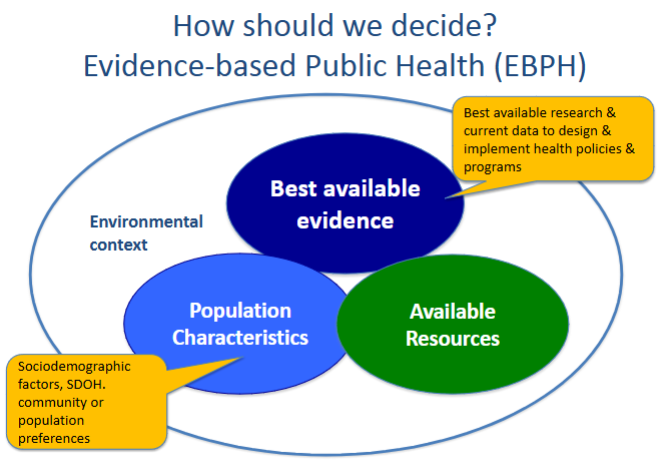
why is EBPH important?
science changes and we need to keep people updated with the most recent data and uncertainties
DARE
example of intervention that flopped due to lack of EBPH
this backfired because DARE exposed kids to the idea of drugs and drug use, causing an increase in drug use in kids
robot babies
increased teen pregnancy because people felt “oh that’s not so bad” —> program that was rolled out for years, lack of evidence-based
Andrew Wakefield
the guy who said vaccines caused autism
where do we go wrong in interventions that flop? (like DARE and robot babies)
bad (or no) science
failure to evaluate
lack of understanding or consideration of social determinants or socio-cultural context
incomplete or inappropriate use
why do we need EBPH?
resources are limited, so we need to focus on most effective interventions
interventions can have unintended adverse effects, so we need to evaluate them
T or F: Not all evidence is created equal
T
Hierarchy of evidence (from subjective to objective)
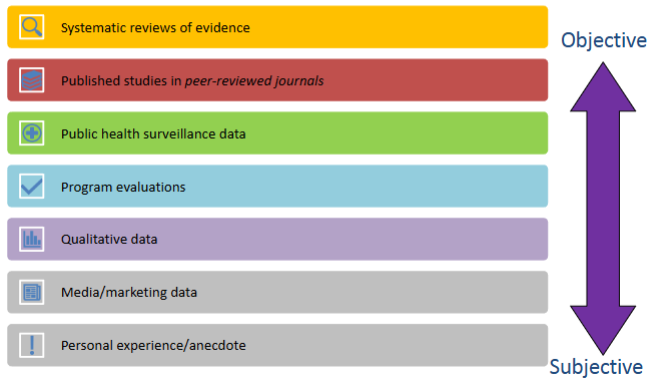
systemic review of evidence
thorough, structured analysis of existing research on a topic
identify patterns, gaps, and reliable evidence to guide further research or decision-making
peer-reviewed studies
at least 3 experts in the field review and criticize the study (leads to accept & publish, reject, or revise & resubmit)
types of research
quantitative and qualitative
quantitative research
test hypothesis, establish casual relationships
numerical data
statistical analysis
used when looking at prevalance (most surveys)
qualitative research
understanding meaning
non-numerical data (interviews)
thematic analysis
steps in evidence-based public health
ask, acquire, appraise, apply, asses
repeats, loops
step 1. in EBPH
ask questions
step 2. in EBPH
acquire evidence
step 3. in EBPH
appraise studies (based on credibility, generalizability, and importance)
step 4. in EBPH
apply the evidence (think about the goal of the program,, the effectiveness, potential burdens, alternatives, etc)
step 5. in EBPH
asses results (did it work? for whome? were there unintended consequences? did the benefits outweigh the costs? should this program be continued)
resources for finding evidence-based interventions
APHA Supporting Research, Campbell Collaboration, Cochrane Library, Cochrane Public Health, Compendium of Proven Community, Health Evidence, Healthy People 2020, National Institutes of Health, US Department of Health and Human Services, US Preventive Services Task Force
evidence-based practice
using the best available scientific evidence to inform and improve PH programs and policies, ensuring interventions are effective and efficient
best available evidence
component in EBPH
best available research and current data to design and implement health policies and programs
start with systemic review
randomized controlled trial
type of scientific experiment where participants are randomly assigned to differente groups to test the effectiveness of a treatment or intervention
credibility (internal generalizability)
can you believe the findings?
generalizable (external generalizability)
can the findings be applied to persons, places or settings that were not directly studied?
significance/importance
are all “significant” findings necessary? Will this have an impact on patient/population health?
T or F: The mental hygiene movement in the early 20th century emphasized ensuring access to clean environments and safe water
F
What is one major challenge in implementing population-based mental health interventions?
Workforce shortages, funding limitations, and lack of policy regulations
T or F: Most technology-based interventions to address loneliness have focused on elderly populations
T
continuum of mental health
“mental illness” to “flourishing”
mental wellbeing
Mental well-being refers to a state of positive psychological and emotional health
What are behavioral/ mental health disorders? How are they defined?
Behavioral/mental health disorders, or mental illnesses, are conditions that affect a person's thinking, mood, and behavior, often causing distress and difficulty in functioning. They are defined by persistent patterns of thoughts, feelings, and behaviors that deviate from the norm, cause significant distress or impairment, and are not simply normal reactions to life events.
impact of loneliness on health
The long-term health consequences of loneliness and insufficient social connection include a 29% increased risk of heart disease, a 32% increased risk of stroke and a 50% increased risk of developing dementia in older adults, according to the surgeon general.
technology-based interventions for loneliness
remote psychotherapies
support groups through social networking sites, social media-based interventions
individual cognitive behavioral therapy (CBT) (phone, video game consoles, tablets)
robots, conversational agents, chatbox
what does a population approach to mental health entail?
A population approach to mental health focuses on improving the mental health outcomes and well-being of a defined group (e.g., community, region, or nation) by addressing the underlying social, economic, and environmental factors that impact mental health, rather than solely focusing on individual treatment
DSM
Diagnostic and Statistical Manual of Mental Disorders, a handbook used by healthcare professionals in the United States and globally as the authoritative guide for diagnosing mental disorders.
Any Mental Illness (AMI)
mental, behavioral, or emotional disorder
vary in impact, ranging from mild, moderate, or even severe impairment
Serious Mental Illness (SMI)
mental, behavioral, or emotional disorder resulting in serious functional impairment
substantially limits or interferes with one or more major life activites
T or F: Classifications of mental illnesses change overtime
T
T or F: It is possible to have poor mental health but no mental illness—and—to have good mental health with a diagnosis of a mental illness
T
Better terminalogy for “Mental Disorders” or “Behavioral Disorders” can be…
Brain Disorders
T or F: Depression can affect brain chemistry
T
Population at higher risk for depression and anxiety
kids aged 12-17
Why are kids at higher risk for mental illness?
2/3 children report experiencing at least one traumatic event by 16
1 in 7 children experience abuse or neglect annually in the US
each day, 14 youth die from homicide, and more than 1,300 are treated for violence-related injuries
areas that childhood trauma can impact
cognition, physical health, emotions, relationships, mental health, behavior, brain development
consequences of an adverse childhood experience (ACES)
increased rate of depression as number of ACES increase → higher in women
T or F: mental health care is expensive
T
primary prevention for mental illness
promote and preserve mental health and well-being
secondary prevention for mental illness
screening those at high risk or in early symptoms of distress
tertiary prevention for mental illness
psychotherapy, medications, other treatments
risk factors of mental illness in children
physical and developmental impairments
attachment issues
risk factors of mental illness in parents
history of abuse
family stress
single parent households
low income and level of education
unemployment
substance use
living in high-crime areas
SDOH of mental health
adverse childhood experiences (ACEs) → abuse, neglect, household dysfunction
example of ACEs and mental health pathway
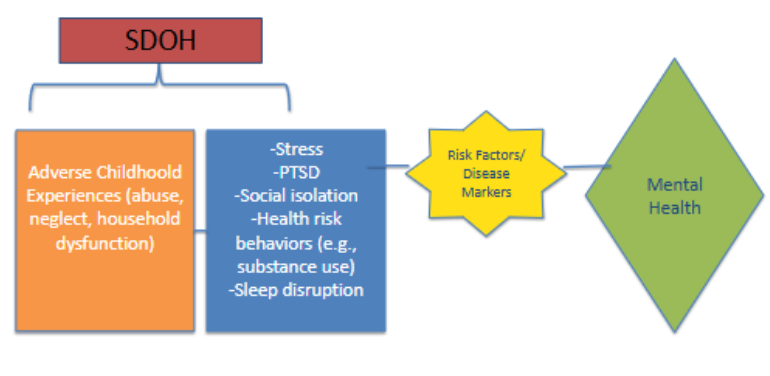
T or F: 1 in 6 individuals under the age of 18 have a diagnosable mental health disorder
F → 1 in 5
T or F: only 20% of children with feelings of depression and anxiety are receiving professional treatment
T
sdohs of mental illness
ACEs, lack of diagnosis and treatment, mental healthcare shortage areas, social media, stigma
stigma of mental illness
people with mental illness are violent (dangerousness)
people with mental illness can’t work or live independently (incompetence)
people with mental illness will not recover (permancence)
the loneliness curve
loneliness peaks in young adulthood and late life, according to Psychological Science
Loneliness decreases with age, but rises again in those in their 50s and 80 and older
Models of undestanding loneliness
social needs, cognitive discrepancy, evolutionary theory
social needs approach to understanding loneliness
objective and subjective relationships do not satisfy the desired social needs
cognitive discrepancy approach to understanding loneliness
(subjective) fulfillment of relationships
evolutionary theory approach to understanding loneliness
feeling of being lonely even in the presence of others is a biological warning system
dynamics of loneliness in young people
shirking parental control, search for meaning, individuation, identity formation, new community, college life
What does ACES stand for?
adverse childhood experiences
continuum of substance use
no use → beneificial use → non-problematic → problematic → potentially harmful use → substance use disorder
Which age group has the highest levels of depression and anxiety?
12-17 year olds
substance use disorder (SUD)
treatable, chronic medical disease involving complex interactions among brain circuits, genetics, the environment, and an individual’s life experiences
a cluster of cognitive, behavioral, and physiological symptoms indicating that the individual continues using the substance despite significant substance-related problems
underlying change in brain circuits that may persist beyond detoxification
continuum of substance use
no use → beneficial use → non-problematic → problematic → potentially harmful → substance abuse disorder
what does a clincial assessmenet for SUD assess? (behavioral addicitions)
unsuccessful efforts to quit/reduce use, use more than intended, cravings, neglect responsibilities, use in risky settings, use despite negative effects, tolerance, withdrawal, use more than intended
What behavioral addiction is recognized by the DSM-V?
gambling
What pharmaceutical industries actions helped fuel the current opioid crisis?
Purdue
goals, pros/cons of harm reduction approaches to SUDs
cons:
potential misuse to easier access: if administered wrong, it can have unintended consequences
normalizes drug use
overlooks underlying issues such as addicitons
harm reduction strategies in themselves cannot reduce addicition → must be coupled w another intervention
what do behavioral and substance use addicitions have in common?
preoccupation
avoiding feelings of discomfort
unable to control behavior
continue to engage
co-occurrence
T or F: Addiction is a chronic disease
T
how do we define a chronic disease?
preventable and treatable
changes biology
if untreated, adverse effects on biological and behavioral functioning
goal of recovery-restored functioning
relapses can occur during or after treatment
what did the war on drugs result in?
unproportionate amount of people in color incarcerated
overdose death rates
overdose tripled
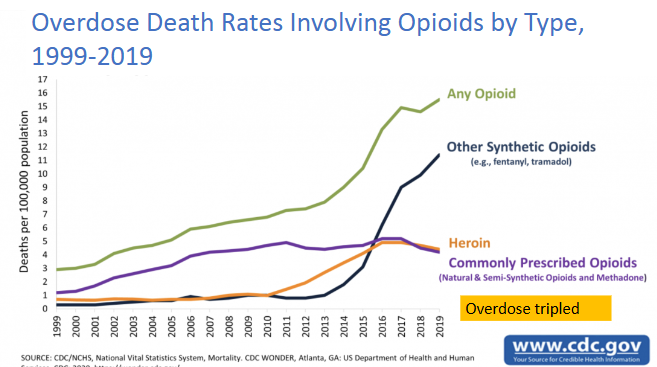
overall rates of overdose deaths decline but…
they have enot declined everywhere → in some places, they have increased → not declining for everyone equally
which race/ethnicity group has the highest amount of overdose deaths?
non-hispanic american indians or alaska native
why was prevalence in drug use increasing until recently?
availability, marketing, failures of government regulation, rising stress levels assocaited with increased socioeconomic inequality, super-normal stimuli, social contagion
potential reasons for recent drug use decrease
greater naloxone availability
greater access to addiction treatment
crackdowns on illicitly manufactured fentanyl
less solitary use post-pandemic
prescription opioids
prescribed by doctors to treat moderate to severe pain but can also have serious risks and side effects
fentanyl
synthetic opioid pain reliever. It is many times more powerful than other opioids and is approved for treating severe pain
heroin
an illegal opioid. Nearly 40 people die every day from an overdose death involving this drug in the US
crime of the century: confluence of events
efforts to improve pain control (5th vital sign)
threat of litigation
aggressive marketing
structure of heathcare → incentives to increase patient volume, satisfaction
physicians not well trained
heath insurance covered opioids but not other forms of pain management
regulatory failures
sdohs of drug use
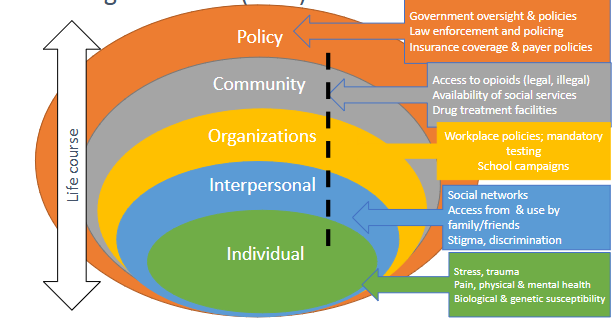
interventions to address SUD
medical assisted treatment → medical approach
needle exchange programs
over-the-counter narcan
supervised consumption sites
safer supply → offer a safer source of the substances
over the counter suboxone (controversial)
medication assisted therapy (MAT)
methadone, buprenorphine & naltrexone (suboxone), naloxone
needle exchange program
provide clean, sterile syringes to people who use injectable drugs in exchange for used ones
reduce the spread of bloodborne infections
increases to narcan (naloxone)
increase availability and legal protections for bystanders
prevent death from overdose
supervised consumption sites
locations for safe drug use with medical oversight
reduce overdose deaths, prevent infections, and provide immediate medical interventions
safer supply
offer a safer alternative to the illegal drug among people who are at high risk of overdose
reduce risk of fentanyl-related overdoses
over the counter suboxone (potential)
reduces opioid cravings and withdrawal symptoms
expand access to MAT
T or F: Smoking is the leading preventable cause of death
T → about 500k deaths per year, 16 million have smoking-related disease
T or F: Smoking can cause cancer almost anywhere in your body
T → based on data accumulated since 1950
T or F: It takes about 20 years for lung cancer to develop
T
T or F: Smoking is a public health success story
T
